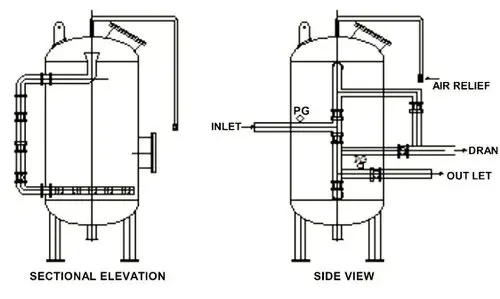Activated carbon filters adsorb pollutants such as organic compounds, chlorine, solvents, and pesticides from liquids or gases. Over time, activated carbon gradually becomes saturated with adsorbed substances. Therefore, regular cleaning and regeneration of the activated carbon are crucial steps to maintain its performance and extend its lifespan. Below are detailed steps on how to properly clean an activated carbon filter and essential precautions to ensure safe and effective cleaning.

Major Cleaning Steps
As the adsorption capacity of activated carbon filters gradually decreases, regular cleaning and regeneration of the activated carbon become indispensable steps to maintain its performance and extend its lifespan. Effective cleaning ensures thorough removal of pollutants adsorbed on the activated carbon, restoring its optimal operational state and ensuring stable filtration effectiveness and system operation.
1. Stop Usage and Preparation
Before cleaning, ensure the activated carbon filter is not in use. Stop the system operation and safely release internal pressure to prepare for the cleaning process.
2. Disassemble the Filter
Depending on the filter's structure, use appropriate tools to disassemble it from the system. Ensure operators are familiar with the equipment to avoid unnecessary damage or hazards.
3. Surface Debris Removal
Use a soft brush, compressed air, or a vacuum cleaner to remove dust, debris, and impurities from the surface of the activated carbon. This step reduces the chemical usage in subsequent cleaning and improves cleaning effectiveness.
4. Backwashing or Flushing
Use reverse airflow or water flow to backwash or flush from the bottom of the activated carbon bed upwards. This step aims to thoroughly rinse and remove impurities and contaminants adsorbed in the activated carbon.
5. Immersion Cleaning
Immerse the activated carbon filter in an appropriate cleaning solution. Choose the cleaning solution based on the type and extent of adsorbed pollutants to ensure effective removal of deep-seated contaminants.
6. Rinse and Repeat Backwashing
Rinse the filter thoroughly with clean water to ensure removal of cleaning solution and residual pollutants. If necessary, perform backwashing or flushing again to ensure all residues are completely removed.
7. Drying
Place the cleaned activated carbon filter in a well-ventilated area to air dry or use appropriate drying methods. Ensure the filter is completely dry to prevent re-absorption of moisture and contaminants.
8. Assembly and Installation
After confirming the thorough cleaning and drying of the filter, reassemble it and reinstall it into the system following the equipment operation manual's guidelines.
Precautions During Cleaning
Cleaning the activated carbon filter is not only a key step in maintaining equipment performance but also a crucial measure for ensuring long-term stable operation of the system. Proper cleaning processes effectively remove pollutants adsorbed on activated carbon, ensuring its adsorption capacity and filtration efficiency. During cleaning, the following precautions are particularly important to ensure safe operation and maximize cleaning effectiveness.
1. Personal Protection
Before starting cleaning operations, operators should wear appropriate personal protective equipment, including goggles, gloves, and respiratory protection, to prevent harm from chemicals and pollutants.
2. Filter Status Check
Before disassembling the filter, ensure the system has stopped operating and internal pressure is properly released to avoid accidental release and harm to operators.
3. Cleaning Solution Selection
Choose an appropriate cleaning solution based on the type of adsorbed pollutants, avoiding overly strong chemical cleaners that may damage the activated carbon and affect its regeneration effectiveness.
4. Backwashing or Flushing Techniques
During backwashing or flushing, control the intensity of airflow or water flow to avoid excessive impact and damage to the activated carbon media. Ensure sufficient backwashing time to thoroughly remove pollutants.
5. Preventing Cross-Contamination
During the cleaning process, especially when handling filters that have filtered different types of pollutants, strictly avoid cross-contamination. Use cleaned equipment and tools separately for different types of filters.
6. Activated Carbon Media Management
Absolutely avoid mixing different types or batches of activated carbon. Different activated carbon media may have different adsorption characteristics, which could result in poor adsorption effectiveness or even failure.
By following these detailed steps and precautions, the cleaning process of activated carbon filters can be safe, effective, and maximally extend their lifespan and maintain their filtration performance. Effective cleaning and maintenance not only protect the equipment but also ensure its long-term reliable operation in environmental protection and industrial applications.

 English
English Español
Español русский
русский